Want to beat the heat and look great in the process? We’ll show you how in this guide to summer hats. Note that we will mostly be discussing classic hats today, so there will be less discussion of utilitarian hat styles—these would include things like bucket hats, outdoor hats, or other types of men’s sun hats that fall outside of classic style.
Best Hats for Warm & Hot Weather
1. Panama Hat
When it comes to warm-weather versatility, there’s arguably no better hat option than the Panama. This iconic style has been popular since the 1800s, and part of what’s made it such a warm-weather staple is that it looks great with everything from a polo shirt to a summer suit.
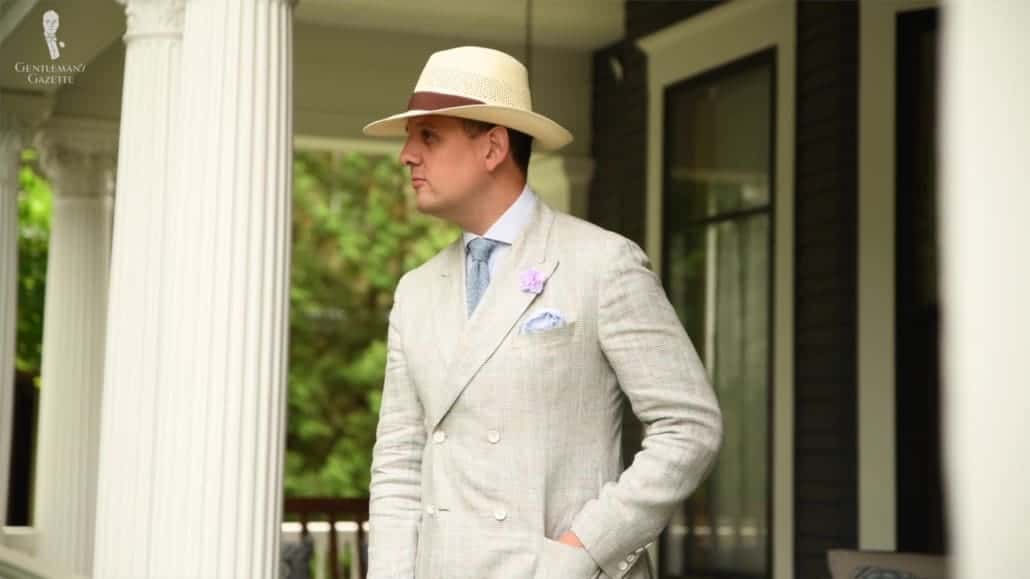
Technically, Panama hats aren’t straw hats, as the traditional models are made from the leaves of the paja toquilla palm tree. They’re also not actually from Panama, as we explain in our dedicated guide, where Raphael will give you even more styling tips.
Learn more about the Panama hat!
You can find some Panama-style hats made from straw, however, which brings us to our next pick.
2. Straw Hats
The only major difference between a Panama Hat and a straw hat is that one is made from palm tree leaves and the other from straw. And while some purists will claim that the only true hats of the highest quality are made from palm leaves, there are certainly quality options made from straw available today; such options just might not be quite as intricately woven as those made by hand in Ecuador.


So, whether your hat is made from palm leaves or straw, you should be able to find one in a variety of shapes and styles, including the fedora, Optimo, planter, or golf hat.
While brim length and weave density, which we’ll discuss in greater detail later, will impact the breathability of any of these hat styles, the shape and characterization mostly just come down to personal taste. So, feel free to pick a style that suits your own personality.
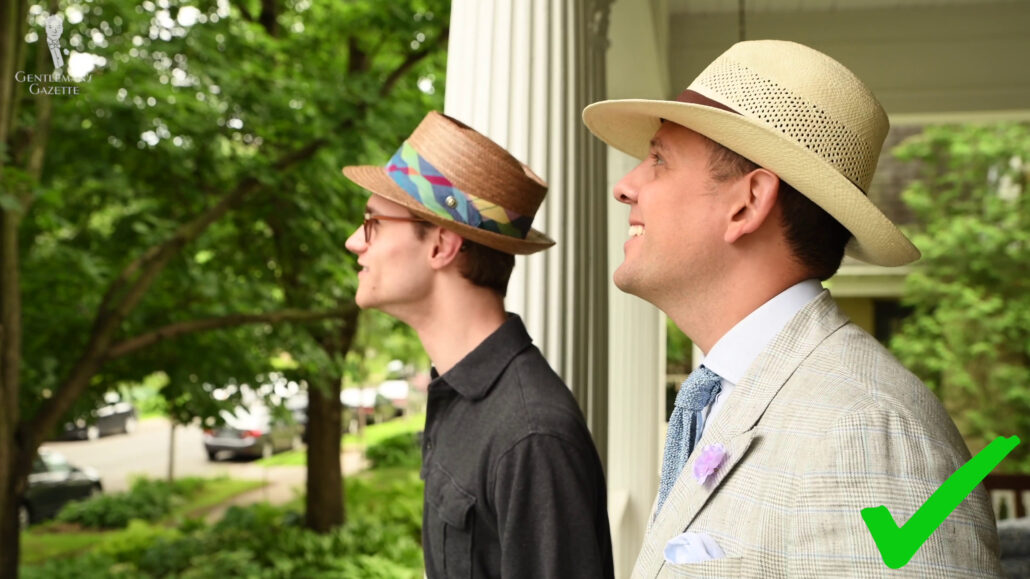
You’ll also find straw versions of many hat styles that are suited for casual ensembles like trilbies and pork pie hats.
Trilby, Homburg, & Pork Pie Hat Guide
Outfit Rundown

A perfect example of a straw hat would be the hat I’m wearing today, which is a pork pie-style made from coconut straw. This hat has a colorful Madras-inspired hatband, and it’s one of my go-to in summer.
By the way, I’ve chosen to pair the hat today with a short-sleeved sports shirt in linen featuring yellow and white stripes from the Australian brand, Coast Clothing. I’ve paired it with plain, medium brown trousers and soft, moccasin-style loafers in tan suede from the brand Velasca.
My socks today are from our own brand, Fort Belvedere, in a two-toned, shadow stripe design of caramel and dark burgundy colors; and for a fragrance today, I’ve gone with the light citrusy tones of DR Harris Classic Cologne. You can find the socks I’m wearing in our Fort Belvedere shop.
3. Boater Hat
If you’re looking for a hat with a decidedly vintage feel, then a straw boater will fit the bill. The boater is a stiffer straw hat, making it more formal but also more fragile and easy to break. In fact, it used to be a tradition to mark the beginning of autumn by punching a hole right through your straw boater. Luckily, you don’t have to follow this tradition anymore.
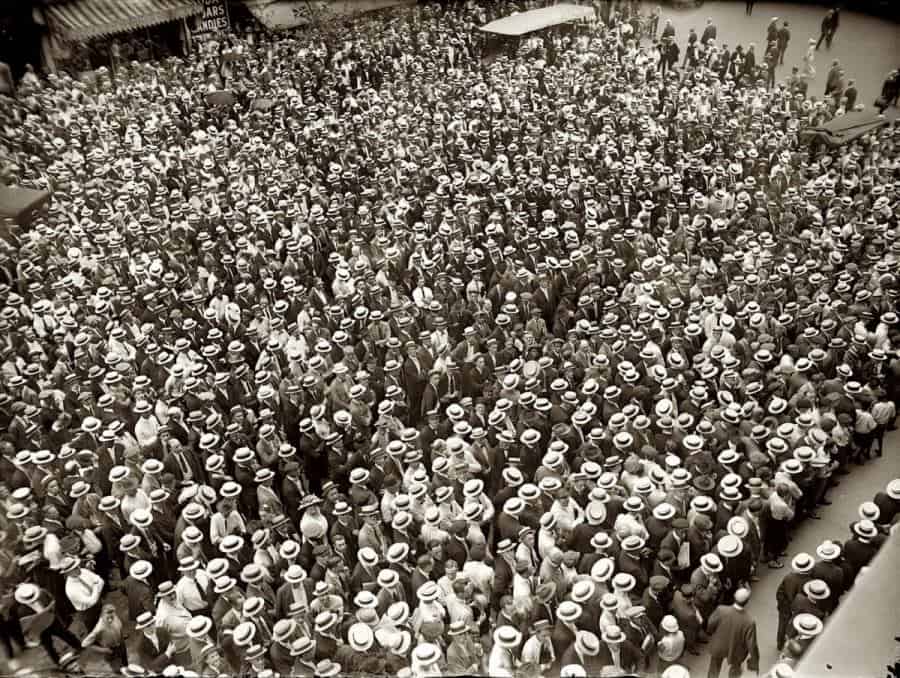
One additional perk of the boater is that it was the traditional choice for a warm-weather Black Tie and pairs particularly well with an ivory or other light-toned dinner jacket. It can also be worn with slightly more casual, tailored outfit fits.
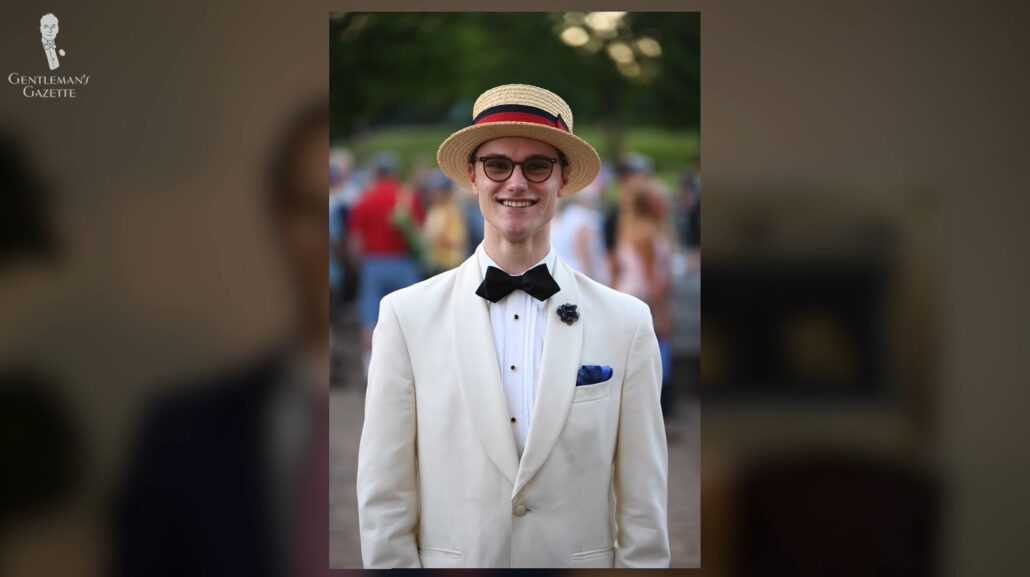

4. Lightweight Felt Hats
Changing gears a bit, let’s now discuss lightweight felt hats. While it might initially seem counterintuitive to wear a felt hat in summer, remember that the traditional cowboy hats and other styles worn by those in the blazing sun of the Wild West were made from felt.

Also, American hat makers like Stetson wouldn’t still be around if their traditional models like the Open Road or the Boss of the Plains weren’t comfortable to wear in warm weather. So, don’t be afraid of wearing a felt hat in certain conditions.
The trick is making sure that the hat is, first of all, constructed of a lightweight felt that is ideally lined with breathable material or unlined inside, and that doesn’t have a thick leather sweatband on the interior but rather a fabric sweatband or none at all.
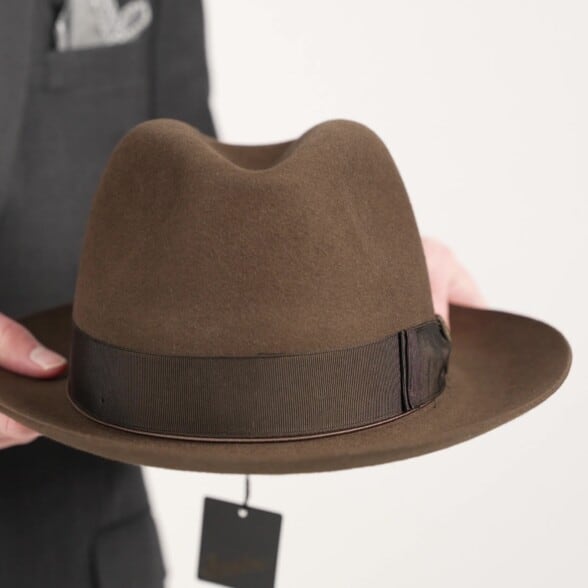
beat the heat With A
Lighter Color and Sweatband
While those leather sweatbands do look great, they can trap heat, creating an unpleasant sweaty ring around your head. Also, to reflect rather than absorb sunlight, opt for felt in light colors like taupe, silver belly, ivory, or tan. These should also blend in quite well with the other elements of your lighter summertime outfits and create a sense of scorpacciata.
If you’d like to know more about the science of how lighter colors contribute to cooling effects, you can learn from Professor Preston in our guide on beating the heat in style.
Summer & Hot Weather Outfits
Generally, warm weather felt hats are going to work best in more casual fedora or Western styles. These will be more seasonally appropriate and match the casual, laidback feel of summertime outfits. While hat styles like derbies and Homburgs do exist in lightweight felt, they tend to be a bit too formal to mesh well with most summer ensembles. You could also consider more marshal and dynamic slouch hats as a bolder option.
While these are a more utilitarian style, they can be a good choice if they suit your personality and if you are wearing them with confidence; and if you are still worried about overheating at the prospect of wearing a wool hat, remember that not all wool is exactly alike. Tropical-weight wool, for instance, is meant to ventilate rather than insulate.


So, while a straw hat will always give the best opportunity for air circulation, remember that warm weather felt hats will not only keep the sun off of your head, but will also keep a pocket of cool air directly above it through the process of evaporative cooling when you sweat. And if you’re dealing with any warm weather rain, then a felt hat will be a good choice here as well as it will maintain its structural Integrity better than a straw hat when inundated with water.
4. Flat/Newsboy Cap
While hat styles with a full, wraparound brim will provide you with the highest degree of sun protection, if you don’t want to wear a hat with a brim that goes all the way around, there are other options available, such as a flat cap or newsboy cap.

While you’ll most commonly see these hat styles made in tweed and other heavy weights of fabric for fall and winter, cotton and linen varieties for summer do certainly exist. These are, again, designed to be breathable and were commonly worn by athletes like golfers and tennis players during the Golden Age of Menswear.
The biggest advantage of these hat styles over straw, which is good for athletes, is their flexibility and durability. But, if you choose to wear a flat cap in the summer months, make sure that you get one in washable material, as they tend to collect sweat and hair products.
5. Baseball Cap
Next, we come to the even more casual and sporty relative of the flat cap, the baseball cap. Yes, even proponents of classic style like us recognize that baseball caps have their appropriate time and place. We do feel, however, that these hats should be reserved for only the most casual occasions, like when you’re at the beach or attending an actual baseball game, and that any more formal outfits are better suited by the other hat styles we’ve illustrated today.
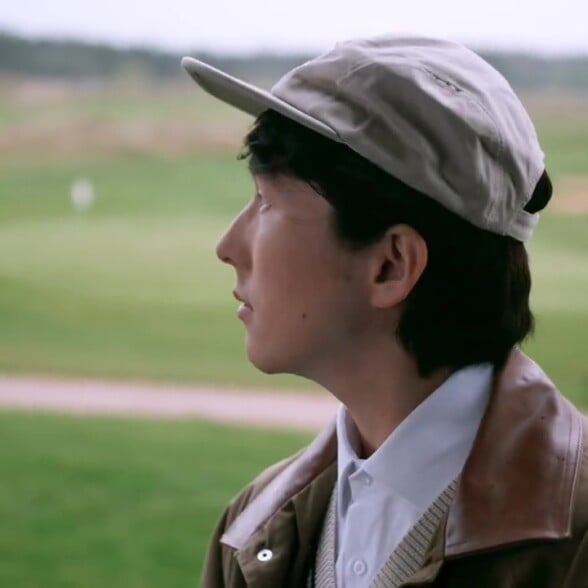
When you do wear a baseball Cap
Keep it simple
When styling a ball cap, we’d recommend sticking to simple block colors and one small logo at the most.
Aside from their excessively casual nature, baseball caps also have a few other drawbacks as well. One of the biggest is that their small brims don’t offer full sun protection, especially when you wear them backwards. Because they sit relatively tightly on the head they also tend to trap heat and sweat, particularly when made from polyester or other synthetic materials.
6. Straw Variants on Other Hats
Finally, for this list, if you’d really like to think outside the box, then there are straw models of other hat styles that can really push the boundaries of classic style, but will work for the right personality.
Something like a straw cowboy hat or gambler hat would be an example here, and it will give more sun protection than some of the other styles we’ve listed. You could take a page from David Suchet’s Hercule Poirot and opt for a straw Homburg hat or from our friend Zack Pinsent of Pinsent Tailoring and opt for a straw top hat. This, in particular, of course, would definitely be more of a choice for historical recreation than for contemporary menswear, however.




Our main point here is there are far more warm weather hat options than just the Panama, so if you’d like to experiment, don’t be afraid of trying to make your warm weather headwear more memorable.
What to Look for in a Warm or Hot-Weather Hat?
Having covered examples of the individual types of hot weather hats, now, let’s briefly look at the quality hallmarks to consider when finding a good warm weather hat.
1. Maximum Breathability
No matter its type or style, you’re definitely going to want to look for a hot weather hat with a good degree of breathability.

While a tightly woven Panama hat might be beautifully made and might accordingly be the most expensive option, there is also something to be said for looser weave straw hats. In fact, there are several different weaving styles in hat making.
Parasisal styles are the most elegant and most finely woven, but these are typically going to be the least breathable among straw options; crochet will often be cheaper and made from slightly less high-end materials, but will be more breathable and more flexible if you need your hat to be able to be thrown around a bit; and braided hats will be similar in stiffness to parasisal styles, but will be constructed in such a way as to allow more air ventilation.



Keep in mind, however, that if your weave is particularly loose, it can also allow more sunlight onto your head, warming you up that way. So, work with different hat styles to find the ideal balance of ventilation and sunlight penetration for you. Your choice will likely depend on local weather conditions and how you personally handle the heat. Furthermore, keep in mind that even for a hat with a very open weave, adding a synthetic lining or band will make that hat less breathable.
As mentioned earlier, for summer hats, it’s often best to go for one without a lining and with a fabric sweatband or none at all.
2. Natural Materials
On that note, as with many things in menswear, hats made from natural materials are typically going to be the better choice. In addition to superior breathability, hats made from natural materials are also, typically, going to have a higher level of quality construction. After all, since these materials are typically more expensive to source in the first place, then cutting corners in the manufacturing process wouldn’t make a whole lot of sense.

While paja toquilla, raffia, and straw are the most common options, not all straw is made equal. Grades of straw are then determined by the density of the weave or how much straw is used per square inch or unit of measurement. Higher-end hats will typically have a tighter weave and be more durable over time, but you don’t have to get overly fussed with straw grading numbers.

Just find a hat that provides a good balance of factors for you as we’ve already outlined; and for fabric hats, just look for cotton, linen, or canvas of high quality with good durability and breathability.
Note also that many manufacturers of warm weather hats today are increasingly turning to paper. This would include Japanese toyo styles made from shellacked rice paper or shantung styles made from braided paper meant to simulate straw. Whether they’re made from synthetic or natural materials, many of these paper hats will still be marketed as “straw hats.”
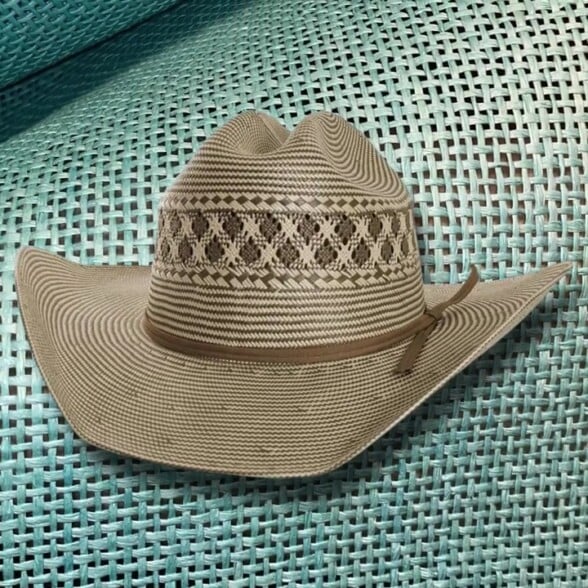
Paper braid hats
They’re not bad, but less durable.
Paper braid hats can have their uses, and just because a hat is made from paper doesn’t automatically mean that it’s bad. Keep in mind, though, that paper hats are less durable overall than their straw counterparts and are particularly susceptible to water damage.
3. Taller Crown & Wider Brim
Next, in general, you’ll want to look for a taller crown and a wider brim. Within reason, having a taller crown on your warm weather hat will allow for heat radiating off of you to dispel further away, preventing you from getting warmer; and if you want to protect yourself from UVB radiation and prevent sunburn, then a wider brim is a good idea.

Look for something like a 2.5-in or 6-cm brim as a good starting point.
4. Seasonal Colors & Versatility
Next, easier outfit coordination can be achieved with seasonally appropriate colors. Of course, the standard tones of tan and beige found in many straw hats will automatically work well with summer ensembles, but you can also find tones of green, red, blue, and other colors that could work well with your outfits.


Due to all of the benefits that a functional summer hat can provide, it’s likely going to be a constant companion for you in the warmer months once you find a good one, so it’s a good idea to find something in a relatively versatile colorway.
In other words, if you’ve only got one summer hat in your wardrobe, then a hot pink cowboy hat style might not be the best one to gravitate toward. Still, there is historical precedent for summer hats to be slightly bolder than their wintertime counterparts, so you can experiment more with color.
Speaking for myself, one of the reasons that my coconut straw pork pie is a go-to for me is because its multicolored Madras-inspired band goes with pretty much any color that I might be wearing elsewhere in my outfit.

Want More Casual Outfit Ideas During Warm Weather?
Conclusion
So, whether you’re dealing with a typical summer or vacationing in a tropical climate, finding a warm weather hat is not only about looking good, but also about finding all of the details that will keep you cool and protected from the sun.
Is there a warm weather hat style we left off of today’s list that’s your preferred choice? If so, let us know in the comments below.
And as a reminder, for the socks I’m wearing today—along with a wide array of other classic men’s accessories, corduroy trousers, and fragrances from the Roberto Ugolini collection—you can visit the Fort Belvedere shop.
FAQ
What is the best material for hats in hot weather?
Any material that is natural, lightweight, and breathable is best; natural fibers like straw & linen are always a safe option.
Should you wear a hat in the hot sun?
Wearing a hat in the hot sun gives you extra protection and style points when worn well
What is the best color hat for heat?
In general, lighter-color hats will offer the most comfortable wearing experience as they will reflect, rather than absorb, heat from the rays of the sun.


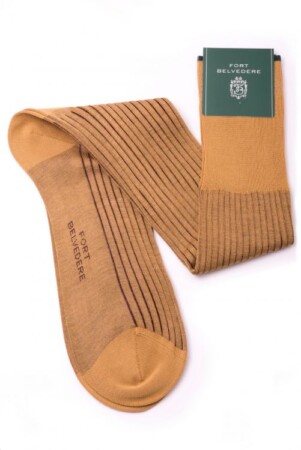
I have a collection of “historical” hats. In summer my favorite is the Panama style. Cooler weather the newsboy type. I abhor modern baseball caps and will not wear them.
I like the Fedora-styled but with a smaller width-brim
I prefer boater hats. Although I don’t see them worn commonly, I wonder why since they seem to sell quite well on sites such as ebay.
Bravo!
Delightfully informative article, as a hat lover myself I certainly enjoy this additional insight on “summer hats” I have several vintage hats in my collection (e.g. homburg, fedora, as well boaters, straw and panama hats). Just one simple inquiry are straw hats and panama hats best suited for formal or causal attire?
Park
I agree with Jay. But for good casual wear, that is very durable may I suggest you look at a Tilly hat. http://www.tilley.com/canada_en/shop_men?cat=44,,, My Tilly goes on walks locally, we’ve done Egypt, Spain, Portugal Canadian Rockies, Caribbean Islands together and afterward just through it in the washing machine and voila, ready for another adventure.
Thank you for this informative article. What hats are appropriate for a (conservative) summer business attire?
Thank you Sven, very handy.
Can anyone recommend a good source for replacement/accessory ribbons for boaters? Usually, they come with either black or “Guards Red and Blue”, but I’d like to be able to get school colors, etc.
This is very informative.
In spite of my love for the look and a desire to wear a Panama hat, I find that with my size 7 1/2, it always appears to me that the hat is so wide it resembles a sombrero!
Wore Panama hat today. Grade 23, exceptionally fine torquilla straw. Always get compliments, and very comfortable to wear.
I resent the common (in all sense of the word) use of “Baseball Cap” to describe what is universal headgear today.
A baseball cap is made of felt, comes in sizes and has an unbroken band. What is mistaken for one is a tractor cap. It is made of various materials including mesh, and has an “idiot loop for sizing.
John Deere, like Levi Strauss, has a lot to answer for.
I prefer hat’s with wider brim, in which I’m not looking like egg-headed monster (that’s how I look in fedora).
And partly due to patriotic reasons, partly because of availiability, I buy hats only from Tonak.
Very informative, but missing one key hat for some of us. I know, this might sound crazy, but the majority of people where I live where cowboy hats. I love the shape, feel, and style of the cowboy hat, but it can really only be pulled off around here where we are actually cowboys and not actors or wearing a costume. It’s good to find one with small vents in the top to keep cool. Black felt is always great for the winter. You don’t even need anything to cover your ears because your head stays so warm.
Great guide though, I’ve definitely always been a fan of the more subtle straw fedora in areas where my cowboy hat gets me a LOT of strange looks…
In my opinion, straw hats always give the impression of a rural traveling salesman who sells wooden ladles from the trunk of a van.
The handkerchief with a knot in each corner is much more traditonal than many of your suggestions
About paper hats: I got a stingy-brim fedora of such material from a street vendor in Manhattan once for $10. Without looking at the label you would have thought it was woven of straw or palm leaf. It was nice-looking, comfortable, and surprisingly durable. Even when it eventually exhibited discoloration from sweat stains, I had no complaints about what I had gotten for my money.
BUT . . .
One of the important virtues of a summer hat, at least for wearers like me who don’t have enough hair on the tops of their heads to protect their cranial skin from solar radiation, is that they should block out direct sunlight, and so reduce the risk of skin cancer. This was one of the considerations that first got me wearing a hat in the summer in the first place. At some point it occurred to me to compare the paper hat with one of my Panamas for sun-blocking power by holding each up against the sun. It was plain to see that the paper hat did very little in this regard. At that point, I ceased to wear it.